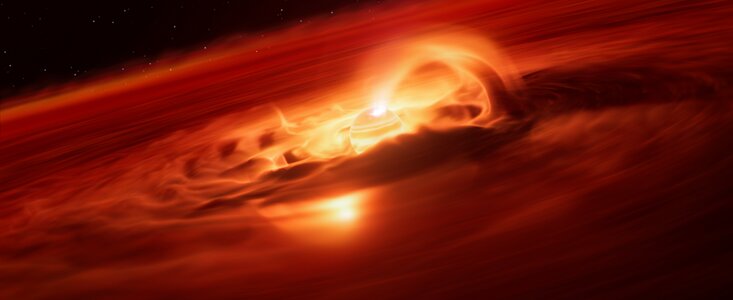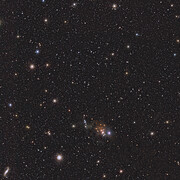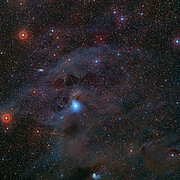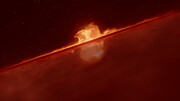Lehdistötiedote
Kuusi miljoonaa tonnia sekunnissa: vaeltava planeetta kasvaa ennätyksellistä vauhtia
2. lokakuuta 2025
Tähtitieteilijät ovat havainneet vapaasti vaeltavan planeetan suuren kasvupyrähdyksen. Toisin kuin aurinkokuntamme planeetat, nämä eivät kierrä tähtiä, vaan ovat itsenäisiä avaruuden kappaleita. Euroopan eteläisen observatorion Very Large Telescope, eli ESO:n VLT-teleskoopilla tehdyt uudet havainnot ovat paljastaneet, että tämä vapaasti vaeltava planeetta kerää ympäristöstään kaasua ja pölyä kuusi miljardia tonnia sekunnissa. Tämä on suurin koskaan mitattu planeetan kasvuvauhti. Havainto antaa arvokasta tietoa vaeltavien planeettojen muodostumisesta ja kasvusta.
"Ihmiset saattavat ajatella planeettoja rauhallisina ja stabiileina maailmoina, mutta tämän löydön ansiosta voimme todeta, että avaruudessa vapaasti vaeltavat planeettojen massaiset kohteet voivatkin olla jännittäviä kohteita", sanoo Víctor Almendros-Abad, joka on tähtitieteilijä Palermon tähtitieteellisessä observatoriossa, Italian kansallisessa astrofysiikan instituutissa (INAF). Hän on tämän uuden tutkimuksen päätekijä.
Tutkimuksen kohteena olevan kappaleen massa on 5–10 kertaa Jupiterin massa, ja se sijaitsee noin 620 valovuoden päässä Kameleontin-tähdistössä. Kohteen virallinen nimi on Cha 1107-7626, ja tämä vapaasti vaeltava planeetta on vielä muodostumisvaiheessa keräten ainetta sitä ympäröivästä kaasu- ja pölykiekosta. Uuta materiaa kertyy jatkuvasti planeetalle prosessissa, jota kutsutaan akkretio- tai kasautumisprosessiksi. Almendros-Abadin johtama ryhmä on nyt kuitenkin havainnut, että nuoren planeetan kasvu ei ole tasaista.
Elokuuhun 2025 mennessä planeetta kasvoi noin kahdeksan kertaa nopeammin kuin vain muutama kuukausi aiemmin, eli nyt kuusi miljardia tonnia sekunnissa! ”Tämä on voimakkain planeetan massaisen kappaleen massan kasvu, joka on koskaan mitattu”, Almendros-Abad sanoo. Löytö, joka on hyväksytty julkaistavaksi The Astrophysical Journal Letters -lehdessä, tehtiin ESO:n VLT-teleskoopin X-shooter-spektrografilla, joka sijaitsee Chilen Atacaman autiomaassa. Tutkimusryhmä käytti tutkimuksessa myös Yhdysvaltojen, Euroopan ja Kanadan avaruusjärjestöjen ylläpitämän James Webb -avaruusteleskoopin dataa sekä ESO:n VLT-teleskoopin SINFONI-spektrografin arkistohavaintoja.
"Vapaasti vaeltavien planeettojen alkuperä on edelleen arvoitus. Ovatko ne kaikkein pienimpiä tähtien tavoin muodostuneita kappaleita, vai jättiläisplaneettoja, jotka ovat sinkoutuneet pois omista syntypaikoistaan?", Aleks Scholz, yksi artikkelin kirjoittajista kysyy. Hän on tähtitieteilijä St Andrewsin yliopistosta Yhdistyneestä kuningaskunnasta. Tulokset viittaavat siihen, että ainakin jotkut vapaasti vaeltavat planeetat saattavat olla muodostuneet samalla tavalla kuin tähdet, koska vastaavia äkillisen massan kasvun pyrähdyksiä on havaittu aiemmin nuorissa tähdissä. Kuten yksi artikkelin kirjoittajista, Belinda Damian, joka on myös tähtitieteilijä St Andrewsin yliopistossa, kertoo: "Tämä löytö hämärtää tähtien ja planeettojen välistä rajaa ja antaa meille kurkistuksen vapaasti vaeltavien planeettojen varhaisimpiin muodostumisvaiheisiin."
Vertaamalla ennen purkausta ja sen aikana emittoitua valoa, tähtitieteilijät saivat lisätietoa kertymisprosessin luonteesta. Huomattiin, että magneettinen aktiivisuus näyttää vaikuttaneen dramaattiseen massan kasvuun. Tämä on prosessi, mikä on aiemmin havaittu vain tähdissä. Tämä viittaa siihen, että jopa pienimassaisilla kohteilla voi olla voimakkaita magneettikenttiä, jotka kykenevät aiheuttamaan tällaisia massan kertymistapahtumia. Tutkimusryhmä havaitsi myös, että planeetan ympärillä olevan kiekon kemiallinen koostumus muuttui massan kasvun aikana. Sen aikana havaittiin vesihöyryä, mutta ei sitä ennen. Sama ilmiö on havaittu tähdillä, mutta ei koskaan missään planeetassa.
Vapaasti vaeltavat planeetat ovat vaikeasti havaittavia, koska ne ovat hyvin himmeitä, mutta tuleva ESO:n Extremely Large Telescope, eli ELT-teleskooppi voi olla tässä apuna. Sen tehokkaiden instrumenttien ja jättimäisen pääpeilin avulla tähtitieteilijät pystyvät löytämään ja tutkimaan näitä yksinäisiä planeettoja lisää. Tämä auttaa tähtitieteilijöitä ymmärtämään paremmin, kuinka paljon ne muistuttavat tähtiä. Kuten yksi artikkelin kirjoittajista ESO-tähtitieteilijä Amelia Bayo toteaa: ”Ajatus siitä, että planeetta voi käyttäytyä kuin tähti, on hämmästyttävää ja saa meidät pohtimaan, millaisia oman kokemuksemme ulkopuolella olevat maailmat voivat syntyvaiheessaan olla.”
Lisätietoa
Tämä tutkimus on esitelty artikkelissa nimeltään “Discovery of an Accretion Burst in a Free-Floating Planetary-Mass Object”, joka julkaistaan The Astrophysical Journal Letters (doi:10.3847/2041-8213/ae09a8) lehdessä.
Tutkimuksessa mukana ovat olleet seuraavat tahot: V. Almendros-Abad (Istituto Nazionale di Astrofisica - Osservatorio Astronomico di Palermo, Italia), Aleks Scholz (School of Physics & Astronomy, University of St Andrews, Yhdistynyt kuningaskunta [St Andrews]), Belinda Damian (St Andrews), Ray Jayawardhana (Department of Physics & Astronomy, Johns Hopkins University, Yhdysvallat [JHU]), Amelia Bayo (European Southern Observatory, Saksa), Laura Flagg (JHU), Koraljka Mužić (Instituto de Astrofísica e Ciências do Espaço, Faculdade de Ciências, Universidade de Lisboa, Portugali), Antonella Natta (School of Cosmic Physics, Dublin Institute for Advanced Studies and University College Dublin, Irlanti) Paola Pinilla (Mullard Space Science Laboratory, University College London, Yhdistynyt kuningaskunta) ja Leonardo Testi (Dipartimento di Fisica e Astronomia, Università di Bologna, Italia).
Euroopan eteläinen observatorio (ESO) tekee maailmankaikkeuden salaisuuksien tutkimisen mahdolliseksi kaikille tutkijoille ympäri maailman. Suunnittelemme, rakennamme ja operoimme huippuluokan maanpäälisiä observatorioita, joita tähtitieteilijät käyttävät jännittävien tutkimusongelmien ratkaisemiseen ja populääritähtitieteen edistämiseen. Me edistämme myös kansainvälistä yhteistyötä tähtitieteen alalla. ESO perustettiin hallitustenväliseksi järjestöksi vuonna 1962 ja nykyään ESO:ssa on mukana 16 jäsenvaltiota (Itävalta, Belgia, Tšekki, Tanska, Ranska, Suomi, Saksa, Irlanti, Italia, Alankomaat, Puola, Portugali, Espanja, Ruotsi, Sveitsi ja Yhdistynyt kuningaskunta) yhdessä Chilen isäntävaltion kanssa ja Australian kanssa strategisena kumppanina. ESO:n pääkonttori ja sen vierailijakeskus ja planetaario, ESO Supernova, sijaitsevat lähellä Müncheniä Saksassa. Chilen Atacaman aavikko on upea paikka, jossa on ainutlaatuiset olosuhteet tähtitaivaan tarkkailuun. Se on kaukoputkiemme sijoituspaikka. ESO:lla on kolme havaintopaikkaa: La Silla, Paranal ja Chajnantor. Paranalissa ESO operoi Very Large Telescope (VLT) kaukoputkea ja siihen liittyvää Very Large Telescope Interferometria sekä paikalla sijaitsevia taivaankartoitusteleskooppeja: infrapuna-alueella toimivaa VISTAa ja näkyvän valon alueella toimivaa VLT Survey Teleskooppia. Paranalissa ESO isännöi ja operoi myös Cherenkov Telescope Array South havaintolaitetta, joka on maailman suurin ja herkin gamma-alueella havaitseva observatorio. ESO operoi yhdessä kansainvälisten kumppaneiden kanssa ALMA-observatriota Chajnantorilla. ALMA tekee havaintoja millimetri- ja alimillimetrin alueella. Rakennamme parhaillaan Paranalin lähelle Cerro Armazonesille "maailman suurinta taivaalle katsovaa silmää”, ESO:n Erittäin suurta kaukoputkea (Extremely Large Telescope, ELT). Santiagossa, Chilessä sijaitsevista toimipisteistämme tuemme toimintaamme Chilessä, ja olemme yhteydessä chileläisiin yhteistyökumppaneihin ja yhteiskuntaan.
Linkit
- Tutkimusartikkeli
- VLT:n kuvia
- Lue lisää ESO:n Erittäin suuresta teleskoopista sen omalta verkkosivulta ja lehdistötiedotteesta
- Median edustaja: saadaksesi julkaisut ennen niiden virallista julkaisemista tilaa uutiskirje omalla kielelläsi.
- Tutkija, onko sinulla kerrottavaa? Pitchaa oma tutkimuksesi.
- ESO:n uusi analyysi on varmistanut, että maailman pimein ja selkein taivas on vaarassa teollisuuden megahankkeen vuoksi
Yhteystiedot
Víctor Almendros-Abad
INAF Astronomical Observatory of Palermo
Palermo, Italy
Puh.: +39 3762144093
Sähköposti: victor.almendrosabad@inaf.it
Aleks Scholz
University of St. Andrews
St. Andrews, United Kingdom
Puh.: +44 (0)1334 46 1668
Sähköposti: as110@st-andrews.ac.uk
Belinda Damian
University of St. Andrews
St. Andrews, United Kingdom
Puh.: +44 (0)1334 46 3098
Sähköposti: bd64@st-andrews.ac.uk
Amelia Bayo
European Southern Observatory
Garching, Germany
Puh.: +49 89 3200 6499
Sähköposti: AmeliaMaria.BayoAran@eso.org
Bárbara Ferreira
ESO Media Manager
Garching, Germany
Puh.: +49 89 3200 6670
Matkapuhelin: +49 151 241 664 00
Sähköposti: press@eso.org
Pasi Nurmi (Lehdistön yhteyshenkilö Suomi)
ESO Science Outreach Network
ja University of Turku
Turku, Finland
Puh.: +358 29 4504 358
Sähköposti: eson-finland@eso.org
Tiedotteesta
| Tiedote nr.: | eso2516fi |
| Nimi: | Cha 1107-7626 |
| Tyyppi: | Milky Way : Planet |
| Facility: | Very Large Telescope |
| Instruments: | X-shooter |
| Science data: | 2025ApJ...992L...2A |
Our use of Cookies
We use cookies that are essential for accessing our websites and using our services. We also use cookies to analyse, measure and improve our websites’ performance, to enable content sharing via social media and to display media content hosted on third-party platforms.
ESO Cookies Policy
The European Organisation for Astronomical Research in the Southern Hemisphere (ESO) is the pre-eminent intergovernmental science and technology organisation in astronomy. It carries out an ambitious programme focused on the design, construction and operation of powerful ground-based observing facilities for astronomy.
This Cookies Policy is intended to provide clarity by outlining the cookies used on the ESO public websites, their functions, the options you have for controlling them, and the ways you can contact us for additional details.
What are cookies?
Cookies are small pieces of data stored on your device by websites you visit. They serve various purposes, such as remembering login credentials and preferences and enhance your browsing experience.
Categories of cookies we use
Essential cookies (always active): These cookies are strictly necessary for the proper functioning of our website. Without these cookies, the website cannot operate correctly, and certain services, such as logging in or accessing secure areas, may not be available; because they are essential for the website’s operation, they cannot be disabled.
Functional Cookies: These cookies enhance your browsing experience by enabling additional features and personalization, such as remembering your preferences and settings. While not strictly necessary for the website to function, they improve usability and convenience; these cookies are only placed if you provide your consent.
Analytics cookies: These cookies collect information about how visitors interact with our website, such as which pages are visited most often and how users navigate the site. This data helps us improve website performance, optimize content, and enhance the user experience; these cookies are only placed if you provide your consent. We use the following analytics cookies.
Matomo Cookies:
This website uses Matomo (formerly Piwik), an open source software which enables the statistical analysis of website visits. Matomo uses cookies (text files) which are saved on your computer and which allow us to analyze how you use our website. The website user information generated by the cookies will only be saved on the servers of our IT Department. We use this information to analyze www.eso.org visits and to prepare reports on website activities. These data will not be disclosed to third parties.
On behalf of ESO, Matomo will use this information for the purpose of evaluating your use of the website, compiling reports on website activity and providing other services relating to website activity and internet usage.
Matomo cookies settings:
Additional Third-party cookies on ESO websites: some of our pages display content from external providers, e.g. YouTube.
Such third-party services are outside of ESO control and may, at any time, change their terms of service, use of cookies, etc.
YouTube: Some videos on the ESO website are embedded from ESO’s official YouTube channel. We have enabled YouTube’s privacy-enhanced mode, meaning that no cookies are set unless the user actively clicks on the video to play it. Additionally, in this mode, YouTube does not store any personally identifiable cookie data for embedded video playbacks. For more details, please refer to YouTube’s embedding videos information page.
Cookies can also be classified based on the following elements.
Regarding the domain, there are:
- First-party cookies, set by the website you are currently visiting. They are stored by the same domain that you are browsing and are used to enhance your experience on that site;
- Third-party cookies, set by a domain other than the one you are currently visiting.
As for their duration, cookies can be:
- Browser-session cookies, which are deleted when the user closes the browser;
- Stored cookies, which stay on the user's device for a predetermined period of time.
How to manage cookies
Cookie settings: You can modify your cookie choices for the ESO webpages at any time by clicking on the link Cookie settings at the bottom of any page.
In your browser: If you wish to delete cookies or instruct your browser to delete or block cookies by default, please visit the help pages of your browser:
Please be aware that if you delete or decline cookies, certain functionalities of our website may be not be available and your browsing experience may be affected.
You can set most browsers to prevent any cookies being placed on your device, but you may then have to manually adjust some preferences every time you visit a site/page. And some services and functionalities may not work properly at all (e.g. profile logging-in, shop check out).
Updates to the ESO Cookies Policy
The ESO Cookies Policy may be subject to future updates, which will be made available on this page.
Additional information
For any queries related to cookies, please contact: pdprATesoDOTorg.
As ESO public webpages are managed by our Department of Communication, your questions will be dealt with the support of the said Department.








